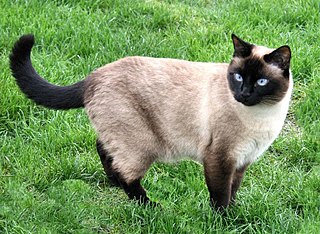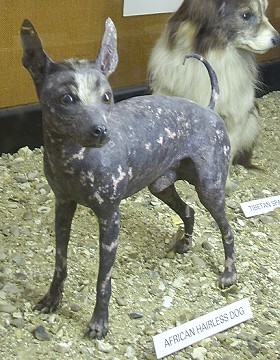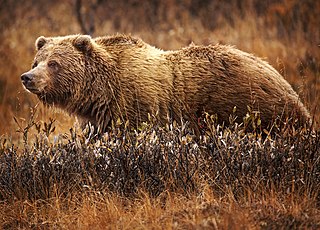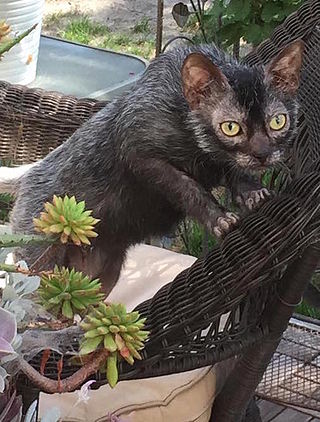Unique traits
Hairless guinea pigs are not significantly physiologically different than regular haired guinea pigs, [4] although they need to eat more to maintain body heat. The optimal temperature range for a hairless guinea pig is 75 to 79 °F (24 to 26 °C), which is slightly higher than the optimal temperature range for the haired guinea pig. [5]
Their skin has a similar appearance to human skin, [6] [7] but has a more rubbery texture. Their skin is quite vulnerable to sunburn, other injuries and fungal infections unless precautions are taken. [4] Baldwin guinea pigs should be housed indoors and they are usually kept with nesting materials such as a blanket, fleece bag or small plastic or wooden house for heat conservation. [4] Heating pads or other external heat sources may be needed when the weather is cold.
The gene causing hairlessness in Baldwin guinea pigs is a recessive gene, and breeding two Baldwins together will always result in all offspring being Baldwins. Breeding a Baldwin guinea pig to a standard haired guinea pig will result in offspring that all carry one copy of the gene, but none will express hairlessness. [8] These offspring are generally called Baldwin carriers. Breeding two Baldwin carriers together will (on average) result in 25% offspring being Baldwins, 50% offspring being Baldwin carriers and 25% offspring being regular haired guinea pigs that do not carry the gene. [9] Since the chance of getting a Baldwin is low, and because it is not possible to visually tell the difference between a haired guinea pig that does carry the gene and one that does not, this method of breeding is not recommended. Haired Baldwin carriers remain haired (looking like normal guinea pigs) their entire life.
There is a second type of hairless guinea pig called the Skinny pig, but its hairlessness is the result of a completely different recessive gene. Breeding a Skinny pig with a Baldwin will result entirely in offspring that are haired yet carry one copy of the gene for Skinny pig hairlessness and one copy of the gene for Baldwin hairlessness. [9]
Even though the Baldwin is a relatively new breed among pet owners and cavy fanciers, it is gaining popularity for its unique appearance. [1]

The guinea pig or domestic guinea pig, also known as the cavy or domestic cavy, is a species of rodent belonging to the genus Cavia in the family Caviidae. Breeders tend to use the name "cavy" for the animal, but "guinea pig" is more commonly used in scientific and laboratory contexts. Despite their name, guinea pigs are not native to Guinea, nor are they closely related to pigs. They originated in the Andes region of South America. Studies based on biochemistry and hybridization suggest they are domesticated animals that do not exist naturally in the wild, descendants of a closely related cavy species such as C. tschudii. They were originally domesticated as livestock for a source of meat, and are still consumed in some parts of the world.

The Sphynx cat also known as the Canadian Sphynx, is a breed of cat known for its lack of fur. Hairlessness in cats is a naturally occurring genetic mutation, and the Sphynx was developed through selective breeding of these animals, starting in the 1960s.

The Chinese Crested Dog is a hairless breed of dog. Like most hairless dog breeds, the Chinese Crested Dog comes in two varieties, without hair and with hair, which can be born in the same litter: the hairless and the powderpuff.

The American Paint Horse is a breed of horse that combines both the conformational characteristics of a western stock horse with a pinto spotting pattern of white and dark coat colors. Developed from a base of spotted horses with Quarter Horse and Thoroughbred bloodlines, the American Paint Horse Association (APHA) breed registry is now one of the largest in North America. The registry allows some non-spotted animals to be registered as "Solid Paint Bred" and considers the American Paint Horse to be a horse breed with distinct characteristics, not merely a color breed.

The Portuguese Water Dog originated from the Algarve region of Portugal. From there the breed expanded to all around Portugal's coast, where they were taught to herd fish into fishermen's nets, retrieve lost tackle or broken nets, and act as couriers from ship to ship, or ship to shore. Portuguese Water Dogs rode in fishing trawlers as they worked their way from the Atlantic waters of Portugal to the waters off the coast of Iceland fishing for cod.

A piebald or pied animal is one that has a pattern of unpigmented spots (white) on a pigmented background of hair, feathers or scales. Thus a piebald black and white dog is a black dog with white spots. The animal's skin under the white background is not pigmented.

The Donskoy cat, also known as Don Sphynx or Russian Hairless, is a hairless cat breed of Russian origin. It is not related to the better-known Sphynx cat whose characteristic hairlessness is caused by a recessive mutation in the keratin 71 gene. The Donskoy's hairlessness, on the other hand, is caused by a dominant mutation.

Point coloration is animal coat coloration with a pale body and relatively darker extremities, i.e. the face, ears, feet, tail, and scrotum. It is most recognized as the coloration of Siamese and related breeds of cat, but can be found in dogs, rabbits, rats, sheep, guinea pigs and horses as well.

The rex mutation is a genetic variation in mammals that results in soft curly fur. These effects are due to changes in the structure of groups of hairs and cross-section of individual hairs. The rexed coats are unusual but occur in cats, rats, rabbits, horses, and dogs. The mutations, infrequent and spontaneous, occur in a variety of genes and genetic regulatory structures. The diversity of genetic factors results in variable coat thickness/density and fur length. A similar mutation can affect the feathers of birds.

A hairless dog is a dog with a genetic disposition for hairlessness and hair loss. There are two known types of genetic hairlessness, a dominant and a recessive type. The dominant type is caused by ectodermal dysplasia as a result of a mutation in the FOXI3 autosomal gene.

The Skinny pig or skinny is an almost hairless strain of guinea pig. Skinny pigs typically have hair on their muzzles, feet, and legs, but are hairless over the remainder of their bodies. Some of them have a thin covering of fuzzy hair on their backs as well. The Skinny pig is not one of the 13 recognized cavy breeds by the American Cavy Breeders Association. A healthy skinny has skin that is mostly smooth, with some wrinkling around the legs and neck. The body is full with no appearance of spine or ribs. Skinnies can come in a variety of skin colors and patterns, including "Dutch", "Brindle", and "Himalayan". The term "skinny" is used for hairless guinea pigs either because it colloquially refers to the exposed skin of the animal, or because it describes their thinner appearance due to their lack of hair.

Junctional epidermolysis bullosa (JEB) is an inherited disorder that is also known as red foot disease or hairless foal syndrome. JEB is the result of a genetic mutation that inhibits protein production that is essential for skin adhesion. Therefore, tissues, such as skin and mouth epithelia, are affected. Blisters form over the entire body causing pain and discomfort, and open sores leave newborn foals highly susceptible to secondary infection. The condition can be categorized into two types of mutations: JEB1 and JEB2. JEB1 is found in Belgian Draft horses, as well as other related Draft breeds. In contrast, JEB2 is found in American Saddlebred horses.

The Abyssinian is a breed of guinea pig that is relatively common as both a pet and show animal. The Abyssinian is set apart from other breeds of guinea pig by its coat, which is marked with radially growing swirls or cowlicks of hair referred to as rosettes.

Fur is a thick growth of hair that covers the skin of almost all mammals. It consists of a combination of oily guard hair on top and thick underfur beneath. The guard hair keeps moisture from reaching the skin; the underfur acts as an insulating blanket that keeps the animal warm.

The popular sire effect occurs when an animal with desirable attributes is bred repeatedly. In dog breeding, a male dog that wins respected competitions becomes highly sought after, as breeders believe the sire possesses the genes necessary to produce champions. However, the popular sire effect is not just down to wanting to produce a champion. For example, in Staffordshire Bull Terriers there are several popular sires who are used by breeders to produce specific colours that are not favoured in the show ring. The popular sire is often bred extensively with many females. This can cause undetected, undesirable genetic traits in the stud to spread rapidly within the gene pool. It can also reduce genetic diversity by the exclusion of other males.

The Himalayan rabbit is a rare medium-sized breed of rabbit easily mistaken for the Californian rabbit. The body is white with colored points, recognized colors are black, blue, chocolate and lilac.

The Lykoi is a breed of cat derived from a natural mutation causing a form of hypotrichia found in domestic short-haired cats. The mutation has occurred in domestic cats over the last 20 years. DNA testing has been done by UC Davis to confirm that the cats do not carry the Sphynx/Devon Rex gene. The breed was developed by Patti Thomas in Vonore, Tennessee.

Flaxen is a genetic trait in which the mane and tail of chestnut-colored horses are noticeably lighter than the body coat color, often a golden blonde shade. Manes and tails can also be a mixture of darker and lighter hairs. Certain horse breeds such as the Haflinger carry flaxen chestnut coloration as a breed trait. It is seen in chestnut-colored animals of other horse breeds that may not be exclusively chestnut.


















